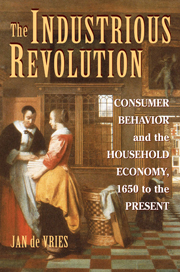Book contents
- Frontmatter
- Contents
- List of Figures
- Preface and Acknowledgments
- 1 The Transformation of Consumer Desire in the Long Eighteenth Century
- 2 The Origins of the Industrious Revolution
- 3 The Industrious Revolution: The Supply of Labor
- 4 The Industrious Revolution: Consumer Demand
- 5 The Breadwinner–Homemaker Household
- 6 A Second Industrious Revolution?
- Bibliography
- Index
5 - The Breadwinner–Homemaker Household
Published online by Cambridge University Press: 05 June 2012
- Frontmatter
- Contents
- List of Figures
- Preface and Acknowledgments
- 1 The Transformation of Consumer Desire in the Long Eighteenth Century
- 2 The Origins of the Industrious Revolution
- 3 The Industrious Revolution: The Supply of Labor
- 4 The Industrious Revolution: Consumer Demand
- 5 The Breadwinner–Homemaker Household
- 6 A Second Industrious Revolution?
- Bibliography
- Index
Summary
Introduction
Toward the middle of the nineteenth century, as the new industrial capabilities brought about by the Industrial Revolution made themselves felt with increasing force throughout northwestern Europe and North America, consumer behaviors had constructed two distinct forms of household economy. Among a growing class of servant-keeping households, a broad array of goods, most owing little directly to the Industrial Revolution itself, brought increasing domestic comfort, fashion, and variety to the middling classes and above. Below these middling classes matters were very different. Here, where the truly industrious households were most numerous, the consumer behaviors that had been developing since well before the Industrial Revolution were viewed by elite observers with concern and even horror. With their multiple income earners, vestigial household production, and individuated consumer aspirations, working-class families appeared to be both dysfunctional and disintegrating. Whether one turns to Frederic Le Play in France, Frederich Engels in England, or Wilhelm Heinrich Riehl in Germany, the founders of family sociology offered the same basic diagnosis: A traditional “family economy” where all members worked together in support of a common enterprise was being undermined by industrial capitalism. As E. P. Thompson so evocatively put it, under industrial capitalism “[t]he family was roughly torn apart each morning by the factory bell,” and the resulting centrifugal forces led its members toward selfish behaviors that began with deplorable consumer preferences, the insubordination of children, the neglect of the home by wives and mothers, and ultimately the dissolution of family ties.
- Type
- Chapter
- Information
- The Industrious RevolutionConsumer Behavior and the Household Economy, 1650 to the Present, pp. 186 - 237Publisher: Cambridge University PressPrint publication year: 2008



